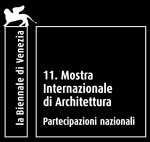Central Catalogue Corpora Text
Posted by Gyula Július on May 20th, 2008, filed in documents
Corpora in Si(gh)te
What can architecture learn from the cities hollowed out from the Cappadocia cliffs, from a wasp’s nest, or even from the structure of an anthill? The architectural project Corpora in Si(gh)te exhibited in the Hungarian Pavilion of the 11th International Architecture Exhibition La Biennale di Venezia explores the possibilities of design based on unique notation systems and local time based informations.
A number of sensors are set up forming a mesh network throughout the area surrounding the Hungarian Pavilion in order to collect and distribute real-time environmental information such as temperature, brightness, humidity, wind direction and sound. The data collected from these sources are processed by a software and translated into nodes reflecting the sensor network. These nodes are the seeds for the virtual architecture of Corpora representing a cellular, distributed network of nodes that are reacting through real-time processing, growing and subsiding like an organism. Each node makes local decisions independently of a central architect. The nodes inadvertently give rise to architectural structures in the Giardini Park. This “information architecture” of nodes has its own spatial perception to make itself transform into various forms by relying on the doubleNegatives Architecture’s super-eye concept. The fluid character of this architecture occurs as a living form. Visitors can observe this process by Augmented Reality Technology, located in various parts of Giardini Park.
The doubleNegatives Architecture team, which consists of Japanese, Swiss and Hungarian artists, works at the frontier of architecture and media art. The corpora main members are, Ákos Maróy, Max Rheiner, Kaoru Kobata and Sota Ichikawa – who founded the group in 1998.
Through this first European presentation of Corpora – as adapted for the Hungarian Pavilion – they point to the transformation of traditional architectural thinking. We are witnessing the converging movement of architecture, design and information technology. We have taken a step in the direction of creating buildings, which “converse” with their environment in an interactive manner, follow the changes in human demands and behave organically. In the process, the secularised division of tasks and labour gives way to a holistic perspective that regards the so-called “digital” space as natural and a part of the environment.
the curator and the corpora team








Leave a Reply
You must be logged in to post a comment.